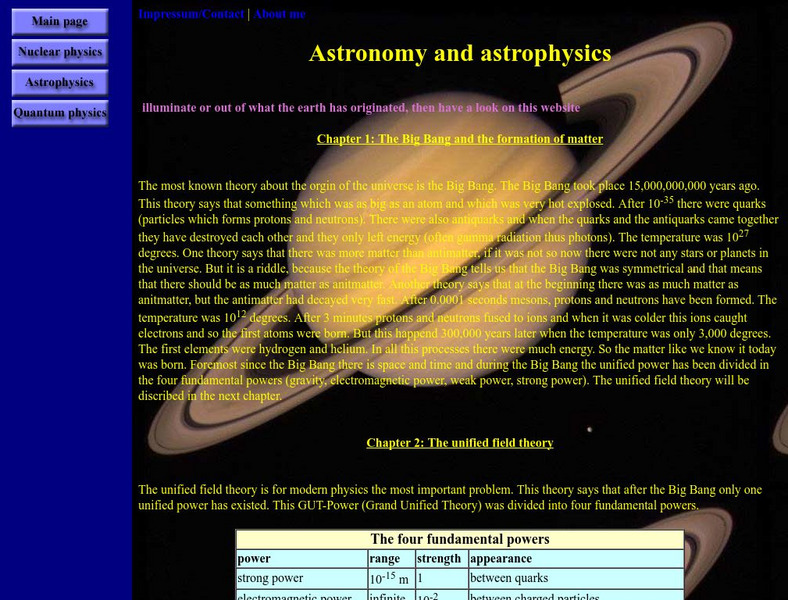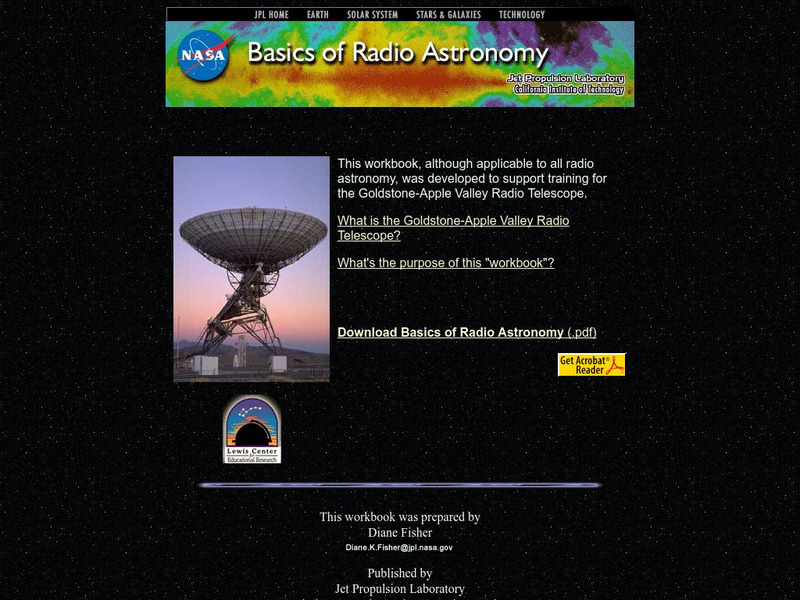Hi, what do you want to do?
Other
What Is Radio Astronomy?: Radio Astronomy at Vla and Vlba
Describes two radio telescopes run by the National Radio Astronomy Observatory (NRAO). The first telescope is called the Very Large Array (VLA) and the second is called the Very Long Baseline Array (VLBA). Both use radio interferometry....
Other
Astronomylinks
This is a very comprehensive site on the subject of Astronomy and Astrophysics. The site has links to many sites on topics including astronauts, astronomy, astrophysics, education, jobs, etc.
Other
Astronomy and Astrophysics
This site is about Astronomy and Astrophysics. The site has plenty of information and links to related topics.
NASA
Nasa Space Science Data Archive: Astronomy and Astrophysics
NASA sponsored site dealing with several topics in Astronomy and Astrophysics. The site provides links to various topics.
Harvard University
Harvard Smithsonian Center for Astrophysics: 1.2 Meter Millimeter Wave Telescope
Describes the collection of 1.2m millimeter wavelength radio telescopes that are operated by the Millimeter Wavelength Group at Harvard Smithsonian. It details some history of radio astronomy and of the telescope itself, gives great...
California Institute of Technology
Submillimeter Wave Astrophysics at Caltech: Caltech's Submillimeter Observatory
Homepage of a radio telescope operated by Caltech in Hawaii. This radio telescope focusses on submillimeter frequencies. Be sure to look at the General Information link for info on telescope and the Astrophysics link to find information...
University of Massachusetts
U Mass Astronomy: Five College Radio Astronomy Observatory
Resource provides basic information about the telescope and research projects being done there.
University of Wisconsin
The Why Files: 3 2 1 Contact, Don't Touch That Dial
A discussion of reflecting telescopes and their use in radio astronomy. The types of information gained from and the research emphasis fueled by such telescopes is described. Site uses Hollywood references and a humorous style.
PBS
Pbs Teachers:origins Back to the Beginning
This hour long program by NOVA is split into six segments and examines a issues influencing scientists' current understanding of how the universe was formed. This includes The Big Bang and its lasting effects.
Other
Nrao: Bringing Your Class to the Vla
Helps teachers arrange a trip to visit the radio telescope VLA. For those of you not near (New Mexico) it also gives connections into the physics, astronomy and electronics courses. It also has a healthy bibliography of sources.
Other
Radio Sky Publishing: Site for Amateur Radio Astronomy
Site describes multiple resources for the beginner amateur radio astronomer. Great general information for beginners on basic radio physics and on the fundamentals of radio telescopes. Nice set of links to other useful sites.
Other
National Radio Astronomy Observatory: Very Large Array
Home page of the NRAO Very Large Array Home Page. This site features an image gallery of photos taken with NRAO instruments and thorough information on radio astronomy.
National High Magnetic Field Laboratory
Magnet Academy: John Daniel Kraus
For a man whose career involved the entire known universe, John Kraus had a remarkably insular upbringing. He was born and raised in Ann Arbor, Michigan, and earned his bachelor's, master's and doctoral degrees in physics, all at the...
National High Magnetic Field Laboratory
Magnet Academy: Karl Jansky
Karl Jansky discovered extraterrestrial radio waves while investigating possible sources of interference in shortwave radio communications across the Atlantic for Bell Laboratories, and is often known as the father of radio astronomy....
National High Magnetic Field Laboratory
Magnet Academy: Edward Purcell
Edward Mills Purcell was an American physicist who received half of the 1952 Nobel Prize for Physics for his development of a new method of ascertaining the magnetic properties of atomic nuclei. Known as nuclear magnetic resonance...
NASA
Nasa: Mission: Science: Electromagnetic Spectrum: Infrared Waves
Infrared light lies between the visible and microwave portions of the electromagnetic spectrum. Infrared light has a range of wavelengths, just like visible light has wavelengths that range from red light to violet.
NASA
Nasa: Electromagnetic Spectrum: Radio Waves
Radio waves have the longest wavelengths in the electromagnetic spectrum. This NASA article discusses AM, FM, TV, cell phone, as well as radio astronomy, which all use this technology.
NASA
Nasa: Basics of Radio Astronomy
Site developed by NASA to support training at the Goldstone-Apple Valley Radio Telescope. A manual in PDF format that covers everything from the basics of electromagnetic spectrum through radio sources through mapping the sky in the...
Other
Nrao: What Is Radio Astronomy?
This page contains an introduction to Radio Astronomy written by the National Radio Astronomy Observatory (NRAO). It contains some basic theory as well as frequently asked questions and teacher resources.
NASA
Electromagnetic Spectrum: Ultraviolet Waves
Ultraviolet (UV) light has shorter wavelengths than visible light. Though these waves are invisible to the human eye, some insects can see them. The specific wavelength values are given. Uses and applications of these waves are explained.
Other
Sky Server: Quasars
This site from the SkyServer offers information as to what quasars are as well as provides links to strange objects, radio astronomy and research. This is a great sit to check out the brief but factual information on the subject.






















